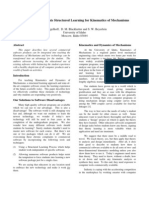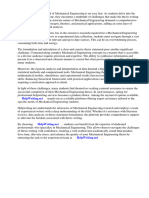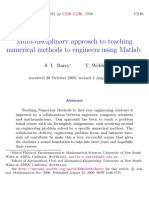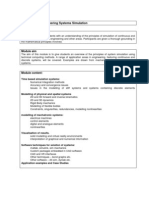0 ratings0% found this document useful (0 votes)
16 viewsReinforcing Learning in Engineering Education by Alternating Between Theory, Simulation and Experiments
Reinforcing Learning in Engineering Education by Alternating Between Theory, Simulation and Experiments
Uploaded by
Nurul HudaThis document describes a method called "Climbing Two Ropes" (C2R) for teaching engineering courses that combines theoretical concepts with hands-on simulations. The method alternates between teaching theoretical fundamentals ("theory rope") and having students apply the concepts through commercial simulation software ("implementation rope"). This approach reinforces learning by allowing students to visualize theoretical applications and solve more complex problems than possible through manual calculations. The document outlines how the C2R method was applied to a finite element analysis course, including alternating between theory lessons and related simulation exercises. Student feedback indicated the approach improved understanding and prepared them for capstone projects and industry work requiring both conceptual knowledge and simulation skills.
Copyright:
© All Rights Reserved
Available Formats
Download as PDF, TXT or read online from Scribd
Reinforcing Learning in Engineering Education by Alternating Between Theory, Simulation and Experiments
Reinforcing Learning in Engineering Education by Alternating Between Theory, Simulation and Experiments
Uploaded by
Nurul Huda0 ratings0% found this document useful (0 votes)
16 views4 pagesThis document describes a method called "Climbing Two Ropes" (C2R) for teaching engineering courses that combines theoretical concepts with hands-on simulations. The method alternates between teaching theoretical fundamentals ("theory rope") and having students apply the concepts through commercial simulation software ("implementation rope"). This approach reinforces learning by allowing students to visualize theoretical applications and solve more complex problems than possible through manual calculations. The document outlines how the C2R method was applied to a finite element analysis course, including alternating between theory lessons and related simulation exercises. Student feedback indicated the approach improved understanding and prepared them for capstone projects and industry work requiring both conceptual knowledge and simulation skills.
Original Description:
Journal
Original Title
CDEN2009
Copyright
© © All Rights Reserved
Available Formats
PDF, TXT or read online from Scribd
Share this document
Did you find this document useful?
Is this content inappropriate?
This document describes a method called "Climbing Two Ropes" (C2R) for teaching engineering courses that combines theoretical concepts with hands-on simulations. The method alternates between teaching theoretical fundamentals ("theory rope") and having students apply the concepts through commercial simulation software ("implementation rope"). This approach reinforces learning by allowing students to visualize theoretical applications and solve more complex problems than possible through manual calculations. The document outlines how the C2R method was applied to a finite element analysis course, including alternating between theory lessons and related simulation exercises. Student feedback indicated the approach improved understanding and prepared them for capstone projects and industry work requiring both conceptual knowledge and simulation skills.
Copyright:
© All Rights Reserved
Available Formats
Download as PDF, TXT or read online from Scribd
Download as pdf or txt
0 ratings0% found this document useful (0 votes)
16 views4 pagesReinforcing Learning in Engineering Education by Alternating Between Theory, Simulation and Experiments
Reinforcing Learning in Engineering Education by Alternating Between Theory, Simulation and Experiments
Uploaded by
Nurul HudaThis document describes a method called "Climbing Two Ropes" (C2R) for teaching engineering courses that combines theoretical concepts with hands-on simulations. The method alternates between teaching theoretical fundamentals ("theory rope") and having students apply the concepts through commercial simulation software ("implementation rope"). This approach reinforces learning by allowing students to visualize theoretical applications and solve more complex problems than possible through manual calculations. The document outlines how the C2R method was applied to a finite element analysis course, including alternating between theory lessons and related simulation exercises. Student feedback indicated the approach improved understanding and prepared them for capstone projects and industry work requiring both conceptual knowledge and simulation skills.
Copyright:
© All Rights Reserved
Available Formats
Download as PDF, TXT or read online from Scribd
Download as pdf or txt
You are on page 1of 4
1
Reinforcing learning in engineering education
by alternating between theory, simulation and experiments
Paul M. Kurowski, Ralph O. Buchal
Department of Mechanical and Materials Engineering
Faculty of Engineering, the University of Western Ontario
pkurowski@eng.uwo.ca, rbuchal@eng.uwo.ca
Abstract
Traditional engineering education has relied on
teaching theoretical fundamentals, reinforced in some
courses by laboratory experiments. However, for
practical reasons experiments are limited in the scope,
and many students fail to make the necessary
connections between the theory and its applications.
To bridge the gap between theory and applications we
use the tools of Computer Aided Engineering (CAE).
The hands-on use of simulation tools such as CAD,
FEA or Motion Analysis helps students visualize and
understand the application of theory to real
engineering problems and allows students to model
and simulate much more complex problems than are
amenable to hand calculations.
At the same time, the use of commercial simulation
software provides students with skills that are in high
demand in the market place.
1 Introduction
The last decade has brought tremendous progress in
Computer Aided Engineering (CAE) tools in
disciplines such as Computer Aided Design (CAD),
Finite Element Analysis (FEA), Motion Analysis, and
Computational Fluid Dynamics (CFD). These CAE
tools have matured enough to become productivity
tools for practicing engineers. By using CAE
applications, engineers are able to shorten the design
process by replacing physical prototyping and testing
with simulation.
Employers expect our graduates to have working
knowledge of CAE applications. Therefore, our
responsibility as educators at Western Engineering is
to equip our students with understanding of
engineering principles along with working skills in the
CAE tools.
How can this be done considering an already very
busy engineering curriculum? How can we possibly
teach the use of CAE software without running the
risk of turning courses into software training where
understanding of the method takes only a secondary
role?
2 Climbing two ropes method
To accomplish the task of teaching students theoretical
background and providing them with skills in
commercial CAE programs such as FEA while
working under severe time constraints (one semester),
we alternate between theory and numerical
simulations of the corresponding problems. Once
students acquire the working knowledge of software
we use the numerical simulation to solve problems
way beyond the reach of hand calculations. This, in
turn, enhances the grasp of theory. This approach may
be descriptively called the Climbing Two Ropes
method or C2R (figure 1).
Figure 1. The essence of the C2R method is a well
timed switching between theory and CAE
implementation
Theory
rope
CAE
Implementation
rope
2
2.1 Description of the method
We explain the method using the third year course
Finite Element Methods for Mechanical Engineering
as an example. The course starts on the
implementation rope. Students use the commercial
software COSMOSWorks to study the modeling
process, necessary simplifying assumptions,
discretization error, convergence and basic modeling
techniques. When we switch to the theory rope to
analyze 1D spring elements, students are already
sufficiently advanced on the implementation rope to
model 1D spring elements with COSMOSWorks.
While confirming hand calculations with software
results students come to appreciate restrictive
assumptions of 1D spring elements and develop skills
in modeling techniques required to simulate them in a
3D model. This deepens the understanding of theory
behind 1D spring elements and further develops
software modeling skills (figure 2).
Figure 2. 1D spring elements on the theory rope are
simulated on the implementation rope with a
COSMOSWorks model
One week later we return to the theory rope to tackle
2D truss elements. They are still simple enough to
allow for manual calculation, yet they are illustrative
because all concepts that apply to 2D truss elements
are fully expandable to real life elements used in
commercial software. We introduce the theory of 2D
trusses and again we simulate them with commercial
software using models of different levels of
idealization (figure 3).
Figure 3. 2D truss elements on the theory rope are
simulated on the implementation rope with
commercial software using models of different levels
of idealization: solid elements (top), shell elements
(middle) and beam elements (bottom).
Climbing on both ropes continues until the end of the
semester, to allow students develop FEA skills ready
for practical implementation as well as good
understanding of the underlying theory.
The course taught with the C2R method is not just a
common mixture of theory and applications. Carefully
measured time intervals spent on each rope produce a
synergic effect benefiting both ropes. Learning is
further enhanced by textbooks used on each rope
(figure 4) [1], [2].
Figure 3 The textbook on the theory rope is a popular
introductory FEA text book [3]. The textbook on the
implementation rope focuses on the applied FEA [4].
A first course in the
Finite Element Method
Engineering Analysis with
SolidWorks Simulation 2009
3
2.2 Course prerequisites
Successful implementation of the C2R method to the
third year course Finite Element Methods for
Mechanical Engineering requires that students be
familiar with CAD. This is because modern FEA
software is so tightly integrated with CAD that FEA
users must be familiar with CAD to be able to use the
FEA.
Western Engineering students are first introduced to
CAD in the first year course Introductory Design and
Innovation Studio. Second year Mechanical and
Materials Engineering students further develop CAD
skills in the course Product Design and
Development. This course introduces students to a
structured design process from inception to
prototyping. CAD is one of many tools used in the
design process and we cant spend too much time on
it. Therefore, students acquire CAD skills not in class
but by working on design projects that require the use
of certain modeling techniques. We run the course in
close collaboration with University Machine Services
(UMS). Members of UMS participate in lectures and
labs to assure that product documentation (including
CAD models) meet industrial standards. To promote
development of CAD skills, a bonus is offered for
passing the SolidWorks certification exam. The
SolidWorks Corporation offers the exam to our
students for free. In the Fall 2008, over 50% of the
MME2259a class (45 students) passed the certification
exam!
Product Design and Development is a prerequisite to
Finite Element Methods for Mechanical
Engineering.
2.3 Evaluation of the effectiveness
To this date we have used the C2R method to teach
Kinematics and Dynamics of Machines, Finite
Element Methods for Mechanical Engineering,
Finite Element Analysis for Design Engineers and
Mechanical Vibration. All together there were ten
courses run with this method. All scored over 6 (out of
7) for effectiveness on students evaluations.
Another way to evaluate the effectiveness is to
monitor students performance in the fourth year,
mainly in the 4
th
year design project. In fact, this year
we have been approached by many students working
on the 4
th
year design project. They were all
successfully implementing the Simulation in the
design process.
Yet another way to evaluate the effectiveness is to
assess the performance of students in the Industrial
Internship Program (IIP) in which some of our
students enroll after completing 3
rd
year. Given a
limited sample size it is difficult to generalize but we
did notice several individuals successfully
implementing both the theory and CAE tools to
solving real life design problems with the skills level
normally expected for an engineer with a few years of
experience.
2.4 Applicability of the C2R method
The C2R is applicable to any course where theory
intertwines with implementation problems suitable for
the CAE tools. One could visualize common
assignments or the same problems passed form one
course to another for different treatments according to
course discipline and objectives. This initiative is now
in progress at Western Engineering.
2.5 Software used
The design curriculum in the MME department has
been standardized on SolidWorks CAD. SolidWorks is
a solid, parametric, feature based program, one of the
most common CAD programs in industry. The C2R
method has been developed around SolidWorks and its
add-ins such as COSMOSWorks and COMOSMotion
Are the acquired skills software-specific? To some
extent they are, but since SolidWorks and its add-ins
feature state-of-the art technology, these skills are
easily transferable to other CAE applications.
3 Next steps
The next phase is to extend the approach to include
physical experiments. Simulations are very useful, but
they are only an approximation of reality. Simulation
results must be verified experimentally, and students
must understand the limitations and implications of
modeling assumptions and simplifications. We
propose to achieve this by introducing simple
experiments to supplement theory and simulations.
This would correspond to adding the third rope:
experiments, and converting where applicable, the
M2R method into a M3R method. For example, a
spring-mass-damper system could be analyzed
theoretically, modeled and simulated using CAE, and
finally experimentally tested. This has already been
implemented in the fourth year elective course
4
Mechanical Vibration and our efforts are underway
to include other courses.
References
[1] D.L. Logan, A First course in the Finite Element
Method, Brooks/Cole
[2] P.M. Kurowski, Engineering Analysis with
SolidWorks Simulation 2009, Schroff Development
Corporation
You might also like
- Asme B30Document1 pageAsme B30Nurul Huda100% (1)
- C-TD - GRade 10 - TG - Module 3 Preparing Computer-Aided DrawingDocument10 pagesC-TD - GRade 10 - TG - Module 3 Preparing Computer-Aided DrawingEssy YetNo ratings yet
- ZTB - Step 1 Study GuideDocument3 pagesZTB - Step 1 Study Guidesam3557No ratings yet
- Book of Dynamic Assessment in Practice PDFDocument421 pagesBook of Dynamic Assessment in Practice PDFkamalazizi100% (1)
- Session S2G Integration of Design and Manufacturing Processes in First-Year Engineering CurriculumsDocument5 pagesSession S2G Integration of Design and Manufacturing Processes in First-Year Engineering Curriculumsvsinisa1No ratings yet
- Dissertation Topics in Cad CamDocument8 pagesDissertation Topics in Cad CamNeedHelpWritingAPaperSingapore100% (1)
- Ac 2011-973: Project-Based Learning (PBL) An Effective Tool To Teach An Undergraduate CFD CourseDocument12 pagesAc 2011-973: Project-Based Learning (PBL) An Effective Tool To Teach An Undergraduate CFD CourseRandhirKumarNo ratings yet
- Journal Paper DRG BX22427430Document4 pagesJournal Paper DRG BX22427430Aman BansalNo ratings yet
- The Design Projects For The Simulation-Based Design CourseDocument12 pagesThe Design Projects For The Simulation-Based Design CourseFahim AkterNo ratings yet
- 2 Module Overview - The Engineering Design ProcessDocument6 pages2 Module Overview - The Engineering Design ProcessMerry Chris TabliganNo ratings yet
- SE and CS Collaboration: Training Students For Engineering Large, Complex SystemsDocument8 pagesSE and CS Collaboration: Training Students For Engineering Large, Complex SystemsrecluzeNo ratings yet
- Software Compliments Structured Learning For Kinematics of MechanismsDocument4 pagesSoftware Compliments Structured Learning For Kinematics of MechanismsSathesh KumarNo ratings yet
- Employing Animatronics in Teaching Engineering DesignDocument12 pagesEmploying Animatronics in Teaching Engineering DesignDamary Kimberly Salinas RodríguezNo ratings yet
- Teaching FEADocument6 pagesTeaching FEALuis Miguel CalvoNo ratings yet
- Virtual Product Development Within A Fourth Year Option in The Mechanical Engineering CurriculumDocument10 pagesVirtual Product Development Within A Fourth Year Option in The Mechanical Engineering CurriculumzazaNo ratings yet
- 11aic Paper GrasppDocument12 pages11aic Paper GrasppCow SepurNo ratings yet
- Bachelor Thesis HFT StuttgartDocument5 pagesBachelor Thesis HFT StuttgartSimar Neasy100% (1)
- Subject For Software Engineering Course MalaysiaDocument10 pagesSubject For Software Engineering Course Malaysiaafiqzaqwan001No ratings yet
- Project-Based Learning of Advanced CADCAE Tools in PDFDocument14 pagesProject-Based Learning of Advanced CADCAE Tools in PDFSOMYA RANJAN TRIPATHYNo ratings yet
- Teaching Finite Element Analysis For Mechanical Undergraduate StudentsDocument18 pagesTeaching Finite Element Analysis For Mechanical Undergraduate StudentsJosé Adalberto Caraballo LorenzoNo ratings yet
- Jawaharlal Nehru Engineering College: Laboratory ManualDocument52 pagesJawaharlal Nehru Engineering College: Laboratory Manualkamleshwari vermaNo ratings yet
- Jawaharlal Nehru Engineering College: Laboratory ManualDocument52 pagesJawaharlal Nehru Engineering College: Laboratory Manualkamleshwari vermaNo ratings yet
- Cloud Computing CepDocument2 pagesCloud Computing CepHabib KhanNo ratings yet
- Paper - Bailey ASEE 2015 FINAL PDFDocument15 pagesPaper - Bailey ASEE 2015 FINAL PDFMirceaNo ratings yet
- Engineering Curriculum Course DescriptionsDocument4 pagesEngineering Curriculum Course DescriptionsJohn MorrisNo ratings yet
- Thesis Dissertation Mechanical EngineeringDocument8 pagesThesis Dissertation Mechanical EngineeringTiffany Daniels100% (2)
- Developing Power Cycles Simulations For An Applied Thermodynamics CourseDocument12 pagesDeveloping Power Cycles Simulations For An Applied Thermodynamics Coursebakisahin2No ratings yet
- Eagle PointDocument5 pagesEagle PointKermelos Habte100% (1)
- Design EngineeringDocument22 pagesDesign EngineeringVishnu S NairNo ratings yet
- Thesis Cad CamDocument4 pagesThesis Cad CamBuyAnEssayOnlineSyracuse100% (2)
- Course Work File Automation in ManufacturingDocument28 pagesCourse Work File Automation in ManufacturingSameer SinghNo ratings yet
- Course Syllabus: Cebu Technological University Ctu-Main CampusDocument5 pagesCourse Syllabus: Cebu Technological University Ctu-Main CampusRicson BondadNo ratings yet
- Smrithi Seet Icse2014 1Document8 pagesSmrithi Seet Icse2014 1csvsmrithiNo ratings yet
- 3D Virtual Learning and Measuring Environment For Mechanical Engineering EducationDocument6 pages3D Virtual Learning and Measuring Environment For Mechanical Engineering Educationrum kaunNo ratings yet
- A Practice Learning of On Board Diagnosis Obd Implementations With Embedded SystemsDocument12 pagesA Practice Learning of On Board Diagnosis Obd Implementations With Embedded SystemsKefin TajebNo ratings yet
- A Hardware Software Centered Approach To The Machine Design Course at A Four Year School of e TDocument10 pagesA Hardware Software Centered Approach To The Machine Design Course at A Four Year School of e TRiki SuryaNo ratings yet
- MT 1571 deDocument22 pagesMT 1571 denikhilrajput686No ratings yet
- Bits WilpDocument22 pagesBits WilpSoumyadip DeyNo ratings yet
- May Training Calendar 2014Document40 pagesMay Training Calendar 2014Raya DuraiNo ratings yet
- MT 1571 deDocument22 pagesMT 1571 deKrishnaaNo ratings yet
- Lab Manual: Visual ModellingDocument45 pagesLab Manual: Visual ModellingSara Latif KhanNo ratings yet
- SEN Experiment PrintoutDocument71 pagesSEN Experiment PrintoutPAURAVI BADIWALENo ratings yet
- Projects OS6eDocument9 pagesProjects OS6eBeer JohnstonNo ratings yet
- CAD Course Student HandoutDocument17 pagesCAD Course Student HandoutDarshanNo ratings yet
- Multi-Disciplinary Approach To Teaching Numerical Methods To Engineers Using MatlabDocument15 pagesMulti-Disciplinary Approach To Teaching Numerical Methods To Engineers Using Matlabshamsukarim2009No ratings yet
- A Concurrent Engineering Project Application in Integrated Mechanical DesignDocument12 pagesA Concurrent Engineering Project Application in Integrated Mechanical DesignMedSparkNo ratings yet
- 8185 26324 1 PBDocument15 pages8185 26324 1 PBnitishdr1231No ratings yet
- Cam and Follower PDFDocument3 pagesCam and Follower PDFManivannan JeevaNo ratings yet
- HNC Mechanical Engineering CourseworkDocument4 pagesHNC Mechanical Engineering Courseworkrhpvslnfg100% (2)
- M Tech Design EngineeringDocument22 pagesM Tech Design EngineeringMounesh7No ratings yet
- Design of A Teachers Training Workshop For ImprovDocument7 pagesDesign of A Teachers Training Workshop For Improvmd.jewel ranaNo ratings yet
- Traffic Sign Recognition For Computer Vision Project-Based LearningDocument8 pagesTraffic Sign Recognition For Computer Vision Project-Based LearningJean Carlos VargasNo ratings yet
- IJEE1527Document7 pagesIJEE1527Irina BancescuNo ratings yet
- DS83 115Document6 pagesDS83 115Paula Andrea Vargas MarinNo ratings yet
- C# ManualDocument71 pagesC# ManualNixarXiddiquiNo ratings yet
- Course Outline: MANF9543 Computer Aided Design & Manufacture (Cad/Cam)Document11 pagesCourse Outline: MANF9543 Computer Aided Design & Manufacture (Cad/Cam)A SNo ratings yet
- C# Lab Manual As On 23-01-2024Document34 pagesC# Lab Manual As On 23-01-2024Raghu NayakNo ratings yet
- Master Thesis Topics For Mechanical EngineeringDocument4 pagesMaster Thesis Topics For Mechanical Engineeringpeggyjohnsonsiouxfalls100% (2)
- MSC Mechanical Engineering Thesis TopicsDocument6 pagesMSC Mechanical Engineering Thesis Topicsoabfziiig100% (2)
- Module Title: Engineering Systems SimulationDocument13 pagesModule Title: Engineering Systems SimulationDeepankumar AthiyannanNo ratings yet
- Et1437 PDFDocument4 pagesEt1437 PDFManish SharmaNo ratings yet
- Mechanical Engineering Design DissertationDocument4 pagesMechanical Engineering Design DissertationBuyPapersOnlineSingapore100% (2)
- Analysis and Design of Marine Structures V Digital PDFDocument4 pagesAnalysis and Design of Marine Structures V Digital PDFNurul Huda0% (1)
- Elastic BeaconsDocument9 pagesElastic BeaconsNurul Huda100% (1)
- Designmodeler: Workshop 5.1 3D CurveDocument8 pagesDesignmodeler: Workshop 5.1 3D CurveNurul HudaNo ratings yet
- Steel Pipes - Pipe Schedule ChartDocument3 pagesSteel Pipes - Pipe Schedule ChartNurul HudaNo ratings yet
- 25 Abaqus ODBDocument6 pages25 Abaqus ODBNurul HudaNo ratings yet
- Response Spectra GenerationDocument16 pagesResponse Spectra GenerationNurul HudaNo ratings yet
- Fatigue Analysis Tool 1.0Document2 pagesFatigue Analysis Tool 1.0Nurul HudaNo ratings yet
- Spring Analysis Tool3Document4 pagesSpring Analysis Tool3Nurul HudaNo ratings yet
- 3.4 Finite Element Analysis of Wind Induced Buckling of Steel TankDocument4 pages3.4 Finite Element Analysis of Wind Induced Buckling of Steel TankNurul HudaNo ratings yet
- City of Glasgow College Full Time Prospectus 2013 - 2014 PDFDocument84 pagesCity of Glasgow College Full Time Prospectus 2013 - 2014 PDFCity of Glasgow CollegeNo ratings yet
- 6-8 Year Old Skill LevelsDocument2 pages6-8 Year Old Skill LevelspratibhaumrariyaNo ratings yet
- Edpg 5 - Greeting Others and Introducing Yourself - New Techlgy Lesson PlanDocument3 pagesEdpg 5 - Greeting Others and Introducing Yourself - New Techlgy Lesson Planapi-346196685100% (1)
- Van Gogh Sunflowers Lesson PlanDocument3 pagesVan Gogh Sunflowers Lesson Planapi-144187933No ratings yet
- Reaction Paper On The Story, RICH DAD, POOR DAD Submitted By: IJ L. MADERA Bot Iii-ADocument2 pagesReaction Paper On The Story, RICH DAD, POOR DAD Submitted By: IJ L. MADERA Bot Iii-AErra Peñaflorida33% (3)
- Local Studies Center As Place For Historical and Genealogical ResearchDocument58 pagesLocal Studies Center As Place For Historical and Genealogical ResearchAslp Librarians100% (1)
- BÁO CÁO THỰC TẬPDocument14 pagesBÁO CÁO THỰC TẬPSunshine's BooksNo ratings yet
- Iia CIA Study TipsDocument2 pagesIia CIA Study TipsMarcus SeeNo ratings yet
- CMRP English Recertification FormDocument3 pagesCMRP English Recertification FormmauricioNo ratings yet
- Throwing Underhand Lesson PlanDocument3 pagesThrowing Underhand Lesson Planapi-373809774No ratings yet
- 5 - Grammar (Interrogative Pronouns) (KSSR)Document4 pages5 - Grammar (Interrogative Pronouns) (KSSR)Mohamad Adib100% (2)
- The Dunn and Dunn Learning Style Model On InstructionDocument30 pagesThe Dunn and Dunn Learning Style Model On InstructionJulia Guan67% (3)
- Ped 372 Lesson Plan 2-Throwing and CatchingDocument7 pagesPed 372 Lesson Plan 2-Throwing and Catchingapi-285295287No ratings yet
- Upsc4All: Directions - (Q. 1-4) Against Each Key Word Are Given Some Suggested Meanings. ChooseDocument14 pagesUpsc4All: Directions - (Q. 1-4) Against Each Key Word Are Given Some Suggested Meanings. Choosepremis4uNo ratings yet
- Annexure F: Form B (Counselling Form For MBBS/BDS Courses)Document15 pagesAnnexure F: Form B (Counselling Form For MBBS/BDS Courses)Kishor PaulNo ratings yet
- 20090309375945770490Document16 pages20090309375945770490kuangte0No ratings yet
- 3 CbcspowerpointDocument23 pages3 CbcspowerpointKrishnaNo ratings yet
- PDSA Work SheetDocument12 pagesPDSA Work SheetAndreas Rumpaka AjiNo ratings yet
- Admission Requirements of Imam Khomeini International University For Non-Scholarship Non-Iranian StudentsDocument3 pagesAdmission Requirements of Imam Khomeini International University For Non-Scholarship Non-Iranian StudentsShakeel AhmedNo ratings yet
- Resume For Teaching English in ChinaDocument4 pagesResume For Teaching English in Chinachfciprmd100% (1)
- GRADES 1 To 12 Daily Lesson Log Sta. Lucia High School Viii Crisanta I. Cañete English Monday Tuesday Wednesday Thursday FridayDocument3 pagesGRADES 1 To 12 Daily Lesson Log Sta. Lucia High School Viii Crisanta I. Cañete English Monday Tuesday Wednesday Thursday FridayCrisanta Ignacio CañeteNo ratings yet
- Copy of Copy of Copy of Shelby de Luna-1Document1 pageCopy of Copy of Copy of Shelby de Luna-1Shelby de LunaNo ratings yet
- DLL in English 7Document6 pagesDLL in English 7Jhastine GatdulaNo ratings yet
- From Our Principal : February CalendarDocument6 pagesFrom Our Principal : February CalendarBailey Lake PtaNo ratings yet
- Clausal Syntax - Introduction To The Course: Instructor: Gabrijela Buljan Office: 94Document18 pagesClausal Syntax - Introduction To The Course: Instructor: Gabrijela Buljan Office: 94josipNo ratings yet
- Problems of Female TeacherDocument31 pagesProblems of Female TeacherSadiq Sagheer71% (7)
- Narrative Report On Project Numbers (Numerals Use To Make Brain Exercise To Reinforce Non-Numerate Students)Document2 pagesNarrative Report On Project Numbers (Numerals Use To Make Brain Exercise To Reinforce Non-Numerate Students)Ako Para Sau100% (7)
- Parent Letter PeDocument1 pageParent Letter Peapi-491062836No ratings yet



































































































